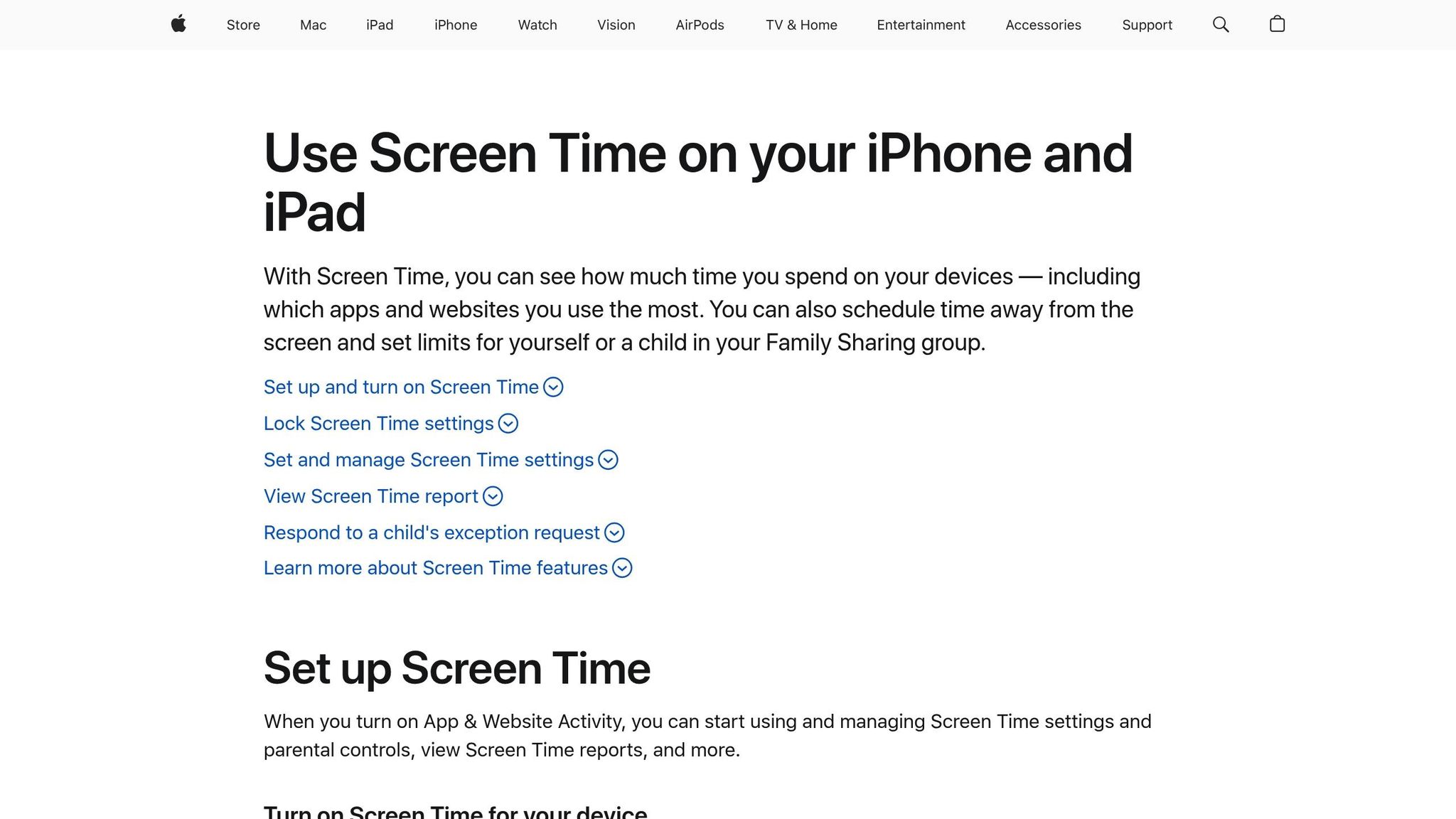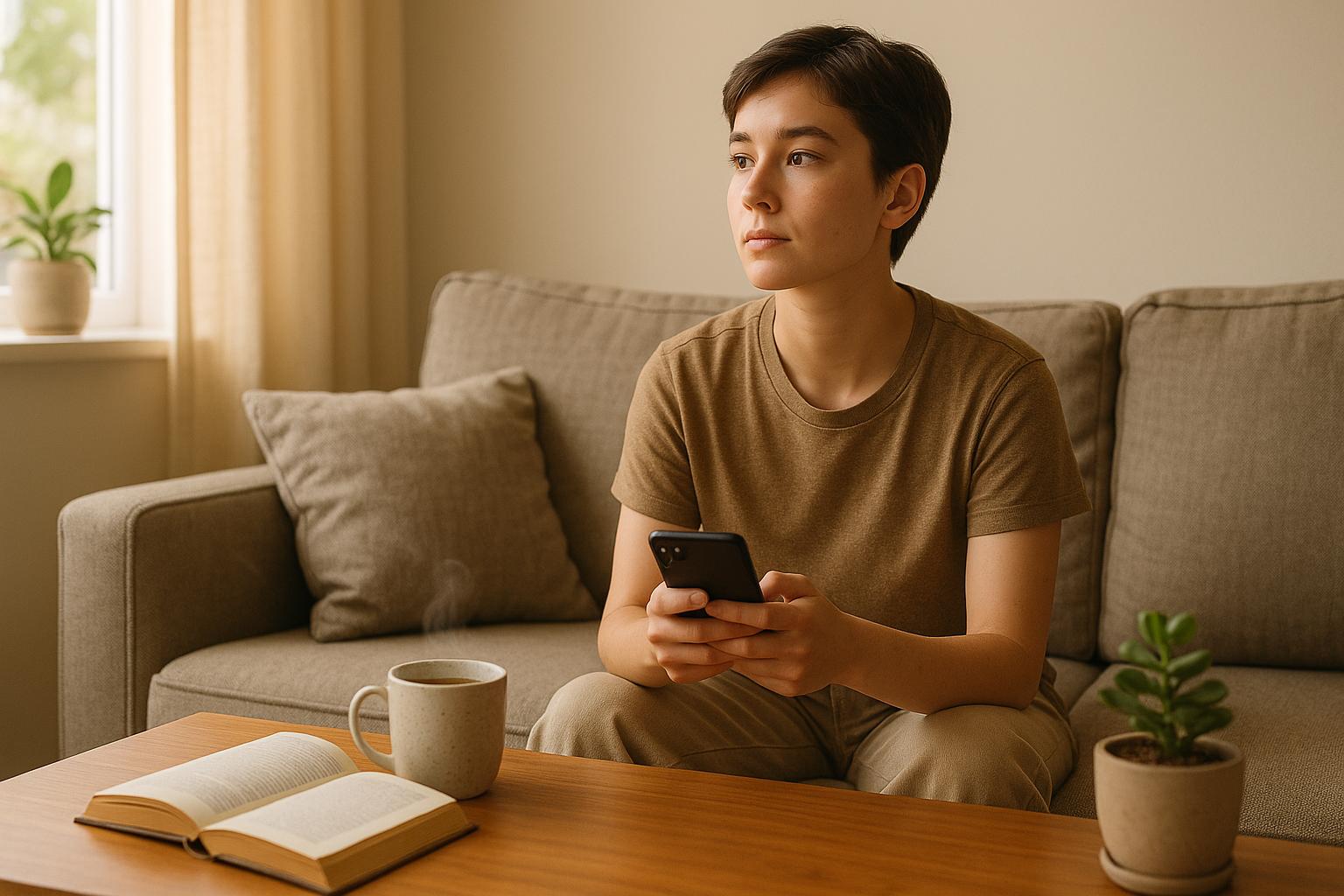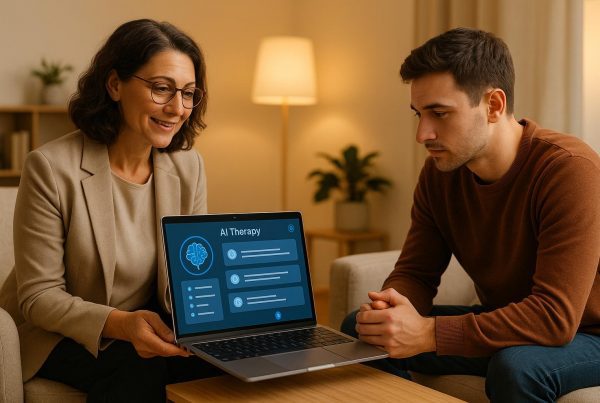Too much screen time can harm your mental health. It’s linked to higher rates of depression, anxiety, and poor sleep, especially in teens who spend over 4 hours a day on devices. To avoid these effects, focus on creating balance. Start by tracking your screen use, setting limits, and replacing excessive screen time with healthier activities like exercise, hobbies, or face-to-face interactions.
Key takeaways:
- Track your usage with built-in tools like Screen Time or Digital Wellbeing.
- Set boundaries by creating screen-free zones (e.g., bedrooms, dining areas) and time limits.
- Replace screen time with offline activities like walking, reading, or socializing.
- Address challenges like FOMO or withdrawal by scheduling phone checks and practicing mindfulness.
Balancing screen use isn’t about quitting entirely – it’s about making small changes to protect your mental well-being while staying connected.
Does Screen Time Affect Mental Health in Adults ? What Science Really Says

Step 1: Check Your Current Screen Time
Start by assessing how much time you actually spend on screens each day. Many people underestimate their screen usage, which makes it harder to pinpoint problem areas or set achievable goals for improvement.
Track Your Screen Time
Most devices these days come equipped with built-in tools to monitor screen usage. Features like Screen Time (iOS), Digital Wellbeing (Android), or Family Safety (Windows) can provide detailed insights into your daily and weekly app usage. These tools can also highlight your most active times of the day and which apps or categories consume the bulk of your time.
For a more complete picture that spans multiple devices, consider third-party apps that sync data from your smartphone, tablet, and computer. This way, you can get a unified view of your total daily screen exposure instead of piecing together reports from individual devices.
To get an accurate sense of your habits, track your screen time for at least one full week before making any changes. This baseline period will help you identify patterns, such as times of peak usage, and highlight any areas of concern. With this data, you’ll be better equipped to evaluate your habits and spot warning signs of excessive screen use.
Recognize Signs of Too Much Screen Time
Once you’ve tracked your screen time, look for physical, emotional, and behavioral signs that might indicate unhealthy usage. These warning signs can help you understand whether your digital habits are starting to have a negative impact.
One of the most common issues is sleep disruption. If you’re struggling to fall asleep, waking up during the night, or feeling groggy in the morning, your screen habits – especially late-night usage – could be to blame.
Another red flag is mood changes. Pay attention to how you feel when you’re away from your devices. If you notice irritability, anxiety, or even depression after long screen sessions, it might signal that your digital habits are affecting your emotional well-being. Research backs this up: teens who spend four or more hours daily on screens report anxiety symptoms at a rate of 27.1%, compared to 12.3% for those with less screen time. Similarly, depression rates jump to 25.9% for heavy users versus 9.5% for lighter users[2].
Difficulty concentrating is another gradual but noticeable effect. You might find it harder to focus on non-digital tasks, experience frequent mind-wandering, or feel compelled to check your phone even during important activities like work meetings or family dinners.
Social withdrawal is a particularly concerning sign. If you’re opting for screen-based activities over in-person interactions, skipping family gatherings, or feeling more comfortable communicating through text or social media than face-to-face, it could be a sign that your screen time is interfering with your relationships.
Physical symptoms are also worth noting. Prolonged screen use can lead to headaches, eye strain, neck or back pain, and even general fatigue.
One of the clearest indicators that screen time has become a problem is when it starts to replace activities that are crucial for your mental and physical health. If you’re skipping exercise, neglecting hobbies, or avoiding meaningful conversations because you’re glued to a screen, this displacement can have a ripple effect on your overall well-being.
Step 2: Set Limits for Better Screen Use
Now that you’ve taken stock of your screen habits, it’s time to put some boundaries in place. The goal isn’t to quit screens entirely – it’s about making small, manageable changes that help you stay in control of your digital life while protecting your mental well-being. Here’s how you can start creating those boundaries.
Make Screen-Free Spaces and Times
One of the best ways to cut down on unnecessary screen time is to create specific places and times where devices aren’t allowed. This helps reduce distractions, improve sleep, and strengthen personal connections.
Start with two key areas: your bedroom and dining space. Keeping devices out of the bedroom can improve your sleep by limiting exposure to blue light, which disrupts melatonin production and your natural sleep cycle. Instead of relying on your phone as an alarm, use a traditional alarm clock. Set up a charging station outside the bedroom to keep devices out of reach at night.
In the dining area, make mealtimes a screen-free zone. Without the distraction of phones or tablets, you can focus on meaningful conversations and enjoy meals more mindfully.
You can also set time-based rules, like avoiding devices after 8:00 PM on weekdays or dedicating weekend mornings to offline activities such as reading, stretching, or simply savoring a cup of coffee – without the pull of notifications.
Set Time Limits and Turn Off Alerts
Built-in tools like Screen Time (iOS) or Digital Wellbeing (Android) make it easy to track and limit your daily app usage. Start by setting limits just below your current usage. For example, if you spend three hours a day on social media, try cutting it down to two and a half hours. Gradual reductions can feel more manageable and help you stick to your goals.
Another effective step is turning off non-essential notifications. Every alert – whether it’s a social media ping or an app update – interrupts your focus and tempts you to check your phone. Review your apps and allow notifications only for what truly matters. You can also use "Do Not Disturb" or similar modes during work hours or at night to minimize interruptions.
For those who need extra support, tools like Aidx.ai offer AI-powered coaching to provide personalized reminders and track your progress, helping you stick to your screen time goals.
Find Other Activities to Do Instead
Reducing screen time doesn’t just mean cutting back – it’s also about finding fulfilling alternatives to replace those digital habits.
Get moving. Physical activities like a 30-minute walk can boost your mood just as much as scrolling through social media, while also reducing anxiety and depression. Whether it’s joining a local sports team, hiking, or doing a quick workout at home, movement is a great way to fill your time.
Explore creative outlets. Hobbies like drawing, painting, playing an instrument, or journaling provide mental stimulation and a sense of accomplishment that screens often don’t. These activities can make excessive screen time less tempting.
Rediscover reading. Picking up a physical book allows you to enjoy the benefits of learning and entertainment without the distractions of notifications. Plus, many libraries host book clubs or reading programs, adding a social aspect to the experience.
Practice mindfulness. Activities like meditation, yoga, or even simple breathing exercises can reduce the stress and anxiety that often lead to excessive screen use. A few minutes of deep breathing can provide a mental reset, giving you the clarity you might otherwise seek from your phone.
Reconnect in person. Face-to-face social interactions are a powerful antidote to the superficial connections often found online. Coffee dates, volunteering, joining community groups, or attending hobby-based meetups can provide deeper, more satisfying relationships.
Research backs up these changes. Studies show that teens who limit their screen time to under four hours a day report significantly lower rates of anxiety (12.3%) and depression (9.5%) compared to their peers who spend more time on screens[2]. By replacing screen time with healthier activities, you’re not just cutting back – you’re actively improving your mental health and building resilience.
sbb-itb-d5e73b4
Step 3: Handle Problems When Reducing Screen Time
Cutting back on screen time is no walk in the park. Even with the best plans and clear boundaries, challenges are bound to pop up. The good news? These obstacles are completely normal, and with the right approach, you can overcome them.
Deal with Fear of Missing Out and Withdrawal
One of the toughest hurdles is fear of missing out (FOMO). That nagging worry that you’ll miss an important update or conversation can make it hard to put your phone down [3]. FOMO often feels like you’re out of the loop on social updates, breaking news, or group chats that seem urgent in the moment. But here’s the truth: most of it isn’t as critical as it feels. To manage this, try setting specific times to check your phone – like 9:00 AM, 1:00 PM, and 6:00 PM – so you’re not glued to it all day.
Then there’s withdrawal – a common but often unexpected challenge. Cutting back on screen time can lead to feelings of irritability, boredom, or anxiety [15, 4]. These symptoms tend to peak in the first few days but gradually fade as your brain adjusts to a new routine.
When withdrawal kicks in, physical activity can be a lifesaver. If you feel that itch to grab your phone, go for a quick walk, stretch, or even do a few jumping jacks. Anything that gets your body moving can help redirect that restless energy.
Another powerful tool is mindfulness. Simple breathing exercises or a few moments of meditation can help you ride out the discomfort without reaching for a screen. Remember, these feelings are temporary, and your brain just needs time to recalibrate.
Once you’ve tackled these initial challenges, you’ll be ready to focus on strategies to keep yourself accountable.
Stay on Track with Your Goals
After addressing those early hurdles, staying consistent requires clear goals and a solid support system. Social support can be a game-changer [2, 3].
Start by sharing your goals with people you trust, like friends or family. Be specific – whether it’s limiting social media to two hours a day or banning phones from the bedroom. When others know what you’re working toward, they’re more likely to cheer you on and less likely to unintentionally derail your progress.
You might also consider joining or starting group challenges, like a "tech-free weekend" or phone-free dinners. Tackling these goals with others can make the process feel less isolating and even fun.
Another key to success is setting measurable goals. Instead of vague plans like "use my phone less", aim for something concrete, like "limit non-essential screen time to 90 minutes on weekdays." Clear targets give you something to track and celebrate.
If you need extra support, platforms like Aidx.ai can be incredibly helpful. They use evidence-based techniques like CBT, ACT, DBT, and NLP to help you manage FOMO, withdrawal, and other emotional challenges. With its voice-enabled interface and adaptive system, Aidx.ai offers real-time coaching and reminders to help you stay on track.
And don’t be discouraged by setbacks – they’re part of the process. If you find yourself scrolling for hours when you planned to stop after one, take a moment to reflect. Were you stressed, bored, or avoiding something? Understanding what triggered the slip-up can help you develop better strategies for the future.
Step 4: Keep Digital Balance Long-Term
Building healthy screen habits is one thing – sustaining them over months or even years is a whole different challenge. Long-term digital balance isn’t about sheer willpower; it’s about embedding those habits into your daily life and creating a support system to keep you on track. This step focuses on taking the boundaries you’ve set and turning them into a natural part of your routine.
Make Screen Time Limits Part of Daily Life
For digital balance to last, your screen habits need to feel effortless, not like a constant battle. The idea is to create routines that gradually reduce your dependence on devices without it feeling like a chore. Let’s dive into ways you can make these habits stick.
Start by carving out consistent tech-free times in your day – moments or activities where screens are simply off-limits. For instance, you might decide that meals are always device-free or that your evenings include a set hour of offline relaxation. Physical boundaries can help too. Something as simple as setting up a charging station outside your bedroom can curb late-night scrolling.
Regular self-checks are essential. Use tools like weekly screen reports to review how you’re doing and adjust as needed. Journaling patterns or noting triggers can also offer insights into what’s working and where adjustments might help.
Keep in mind, the goal isn’t to be perfect. Life changes, and so do your needs. Some months, you might focus on cutting down evening screen time, while others could be about exploring new offline hobbies. Staying flexible while keeping your overall balance intact is key.
Research backs this up: people who maintain digital balance treat it like any other wellness practice. Planning offline activities – like a Saturday morning hike or a weekly art class – can help ensure these habits remain part of your life for the long haul.
Get Support from Others
Once you’ve established routines, having support from others can make all the difference. Social connections play a big role in maintaining healthy screen habits[1].
Family-wide goals, such as device-free dinners or outdoor activities, can strengthen everyone’s commitment to digital balance. Studies show that family-based approaches to reducing screen time are particularly effective because they address the social dynamics of device use[1][4].
Friends can also help keep you accountable. Sharing specific goals – like avoiding social media on weekdays or keeping phones out of the bedroom – can provide motivation. Group challenges, like a tech-free Sunday morning, add a fun, collective element to your efforts.
For those looking for more structured support, tools like Aidx.ai can be a game-changer. These AI-powered coaching platforms use evidence-based techniques such as CBT, ACT, and DBT to help you build sustainable habits. Aidx.ai’s Adaptive Therapeutic Intelligence system learns from your behavior and offers real-time coaching. Whether it’s a gentle nudge during offline moments or strategies to manage the urge to check your phone, these tools provide personalized guidance.
Digital coaching tools are especially helpful for navigating tricky moments – like during commutes, workouts, or when you’re tempted to reach for your phone. Tracking your progress, whether through built-in device features or a coaching app, can help you celebrate wins and pinpoint areas for improvement[1].
The rewards of maintaining digital balance are undeniable: better sleep, stronger relationships, and a clearer mind. These benefits make the effort worthwhile, offering a steady source of motivation to keep going.
Conclusion: Find Balance for Better Mental Health
Taking control of your screen time isn’t just about cutting back on devices – it’s about reclaiming your mental well-being and creating space for what truly matters. Whether you’re tracking your usage, setting boundaries, or managing digital cravings, each step contributes to healthier habits that can positively shape your mental wellness for the long run.
Research shows that keeping screen time under 4 hours a day can significantly reduce anxiety and depression[2]. This shift isn’t just about numbers – it translates to better sleep, improved mood, and stronger personal connections.
By making practical changes, you’re opening the door to a range of benefits. Balanced screen use can lead to higher physical activity levels, deeper conversations, and more time for creative or outdoor pursuits. The hours once spent scrolling can now be devoted to the things that genuinely enrich your life.
It’s important to remember that balance looks different for everyone. Some people thrive with strict no-tech zones, while others find success with more flexible limits. The key is discovering what fits your lifestyle and sticking to it. Tools like weekly screen reports, journaling your patterns, or identifying triggers can help you fine-tune your approach and make adjustments when needed.
This approach also directly addresses challenges like FOMO and withdrawal. By tackling these hurdles head-on, you’ve equipped yourself with strategies to stay on track. Support systems – whether through family, friends, or tools like Aidx.ai, which offers personalized coaching based on evidence – can make a world of difference in maintaining your progress.
Your mental health is just as important as your physical health. By taking steps to balance your screen time, you’ve invested in better focus, stronger relationships, improved sleep, and a greater sense of fulfillment. Over time, these small changes can lead to lasting improvements in your overall quality of life.
FAQs
How can I monitor and manage my screen time across all my devices?
To get a handle on your screen time, start by tapping into the tools your devices already offer. For example, iOS users can check out Screen Time, while Android users can explore Digital Wellbeing. These built-in features break down how much time you spend on specific apps or activities. If you’re using other devices, dig into the settings or explore third-party apps that work across multiple platforms.
Once you’ve got the numbers, set practical limits on apps that eat up your time and plan for regular breaks. You might also want to designate certain areas or times as "device-free" to help curb your screen reliance. Small, consistent changes like these can gradually build better habits.
How can I manage withdrawal or FOMO when trying to cut back on screen time?
Reducing screen time can feel tough at first, especially if you’re dealing with withdrawal or that nagging fear of missing out (FOMO). A good way to start is by setting small, realistic goals – like choosing specific times to unplug or limiting your screen use to certain activities. Over time, you can gradually increase these limits as you get more comfortable.
When FOMO kicks in, remind yourself that it’s perfectly fine to skip some online content. Instead, direct your energy toward offline activities that genuinely make you happy. Whether it’s spending time outdoors, catching up with loved ones, or diving into a favorite hobby, these moments can be far more fulfilling. Establishing a daily routine with clear boundaries can also help shift your focus and make the process feel more manageable.
How can I manage screen time effectively to support my mental health?
To maintain a healthy balance between screen time and mental well-being, it’s essential to set clear limits for device use. Designate specific times for activities like checking emails or scrolling through social media, and make an effort to stick to those boundaries. Incorporate regular breaks by engaging in offline activities such as exercising, reading a book, or simply enjoying some time outdoors.
Establishing a routine that works for you is equally important. Start by prioritizing quality sleep – try to avoid screens for at least an hour before bedtime to promote better rest. Tools like app timers or screen time trackers can help you monitor usage and make adjustments over time. Building better habits doesn’t happen overnight, but small, steady changes can make a big difference in supporting your mental health.



